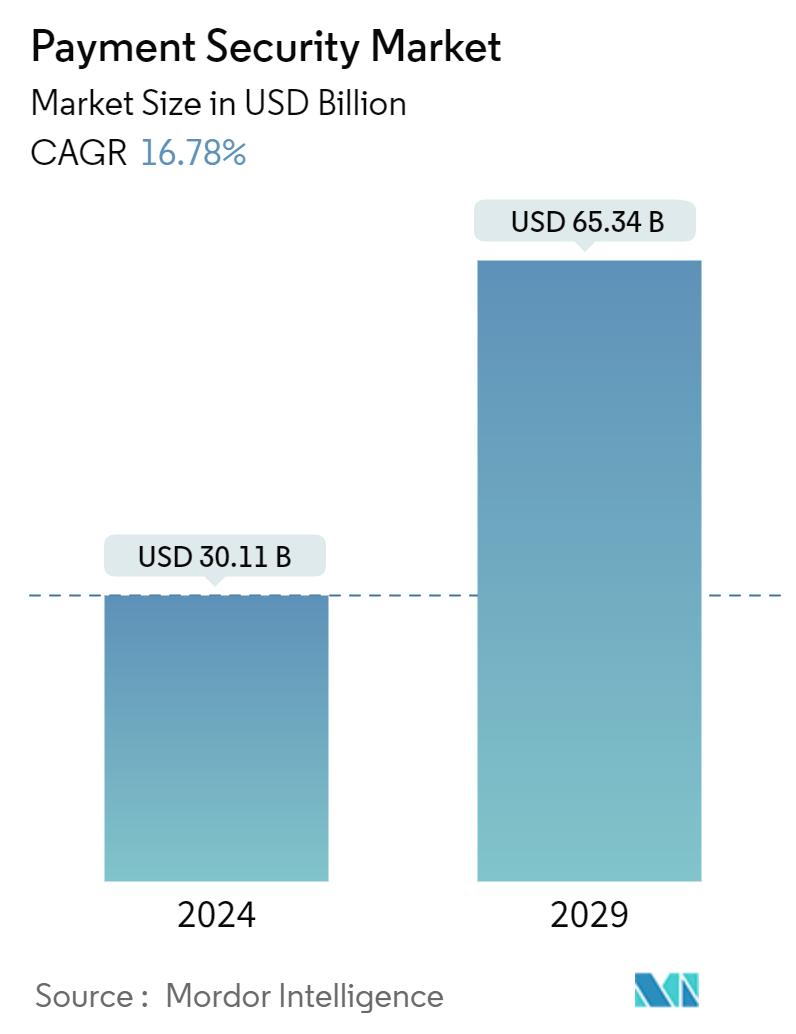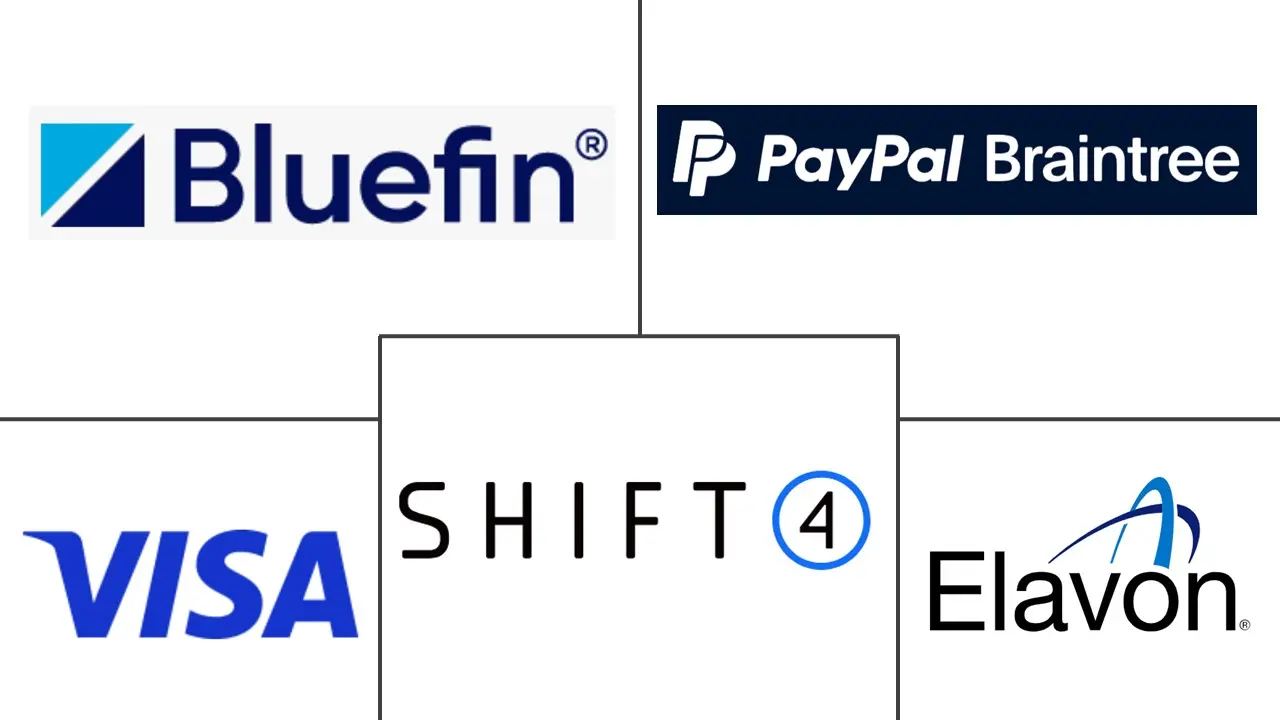Market Size of Payment Security Industry

| Study Period | 2019 - 2029 |
| Market Size (2024) | USD 30.11 Billion |
| Market Size (2029) | USD 65.34 Billion |
| CAGR (2024 - 2029) | 16.78 % |
| Fastest Growing Market | Asia Pacific |
| Largest Market | North America |
Major Players
*Disclaimer: Major Players sorted in no particular order |
Payment Security Market Analysis
The Payment Security Market size is estimated at USD 30.11 billion in 2024, and is expected to reach USD 65.34 billion by 2029, growing at a CAGR of 16.78% during the forecast period (2024-2029).
The payment security market plays a pivotal role in safeguarding digital transactions as the global shift towards online and mobile payments accelerates. The rising adoption of payment security solutions is driven by the increasing number of digital payment modes, necessitating robust mechanisms to protect sensitive financial data. This market encompasses a wide array of solutions such as payment encryption, secure transaction processing, and adherence to compliance standards like PCI DSS (Payment Card Industry Data Security Standard). As e-commerce expands, payment security becomes increasingly critical to prevent fraud and maintain consumer trust.
Significant Fundamentals in Payment Security
- Integration Across Platforms and Industries: The payment security market integrates across various platforms and industries, each presenting unique challenges and opportunities. Mobile-based and web-based platforms are at the forefront, catering to sectors such as retail, healthcare, and IT. The demand for secure payment gateways, payment authentication, and payment fraud prevention tools is escalating due to the widespread use of online payment systems. This growing reliance highlights the need for enhanced payment security solutions, emphasizing the importance of protecting payment card security and ensuring secure transaction processing.
- Competitive Market Landscape: The payment security market is highly competitive, with key players like CyberSource Corporation (Visa Inc.), Bluefin Payment Systems LLC, and Braintree Payment Solutions LLC leading innovation. These companies offer solutions focused on payment data protection, secure payment gateway services, and compliance with industry regulations. Their role is crucial in shaping the industry outlook, ensuring that necessary safeguards are in place as payment methods continue to evolve, thereby influencing market trends and overall industry growth.
Expanding Digital Payment Modes and E-commerce Frauds
- Digital Payment Adoption and Security Needs: The rapid adoption of digital payment modes is transforming the global financial landscape. The proliferation of smartphones and increasing internet penetration is driving more consumers toward mobile and online payment systems. This trend is particularly prominent in emerging economies with growing digital infrastructures. As digital payments become more prevalent, the demand for robust payment security solutions intensifies. Essential features such as payment encryption, secure transaction processing, and payment authentication are becoming crucial components of any payment security solution, ensuring that consumer data is protected throughout the payment process.
- E-commerce Fraud and Security Solutions: The rise of e-commerce has led to an increase in fraudulent activities, making payment fraud prevention a top priority for businesses. With the growth of online shopping, the risk of fraud, particularly in payment card security breaches and unauthorized transactions, has surged. This has resulted in the widespread adoption of e-commerce payment security solutions designed to detect and prevent fraudulent activities in real-time. Companies are implementing advanced payment security software that utilizes artificial intelligence and machine learning to analyze transaction patterns and flag suspicious activities. Additionally, secure payment gateways ensure that all transactions are processed securely, minimizing the risk of data breaches and fraud.
Addressing Trust Issues in Online Payments
- Building Consumer Trust in Digital Transactions: Despite the advantages of digital payments, building consumer trust in online payment modes remains a significant challenge. Concerns about payment security compliance, data breaches, and fraud have made some consumers hesitant to adopt digital payment methods. This has led to a push for more transparent and secure payment processes, with companies focusing on enhancing payment data protection and compliance with industry standards like PCI DSS. Educating consumers about the safety measures in place and providing assurance through secure payment gateways and payment authentication processes are essential steps in overcoming these trust barriers.
- COVID-19's Impact on Payment Security: The COVID-19 pandemic has accelerated the adoption of digital payment methods as consumers and businesses seek contactless and remote payment solutions. However, this rapid shift has also exposed vulnerabilities in existing payment security infrastructures. As a result, there has been an increased focus on strengthening payment encryption and secure transaction processing to handle the surge in digital transactions. The need for reliable and secure payment security software has never been more critical, as businesses adapt to the new normal and strive to protect their customers' financial data in an increasingly digital world.
Payment Security Industry Segmentation
Payment security refers to the protocols implemented by payment merchants to mitigate the risk of fraud. In the absence of these essential security measures, payment merchants, along with their customers, become vulnerable to fraudulent activities. As digital transactions surge, the necessity for robust payment security solutions becomes paramount. The market is segmented based on the platforms utilized for payments across diverse end-user industries and geographies.
The Payment Security Market is segmented by platform (mobile-based, web-based), by end-user industry (mobile-based, healthcare, retail, IT and telecom, travel and hospitality), and by geography (North America, Europe, Asia Pacific, Latin America, Middle East and Africa). The market sizes and forecasts are provided in terms of value (USD) for all the above segments.
| By Platform | |
| Mobile Based | |
| Web Based | |
| Other Platforms |
| By End-user Industry | |
| Retail | |
| Healthcare | |
| IT and Telecom | |
| Travel and Hospitality | |
| Other End-user Industry |
| By Geography*** | |||||
| |||||
| |||||
| |||||
| Australia and New Zealand | |||||
| Latin America | |||||
| Middle East and Africa |
Payment Security Market Size Summary
The payment security market is experiencing significant growth, driven by the increasing shift towards online shopping and transactions, as well as the rise in sophisticated data thefts and payment frauds. The demand for secure payment processing solutions is bolstered by the need to protect sensitive information and ensure compliance with Payment Card Industry Data Security Standards. The proliferation of digital payment methods, including credit/debit cards, mobile wallets, and internet payments, is further propelling the market's expansion. The COVID-19 pandemic has accelerated this trend, as more consumers and industries rely on secure online payment systems. The retail sector, particularly e-commerce, is a major contributor to this growth, with mobile payment security becoming a critical concern for both consumers and financial service providers.
North America is a key region in the payment security market, benefiting from substantial investments in advanced technologies and a strong presence of payment security vendors. The region's market growth is fueled by the rapid adoption of end-to-end encrypted payment security technologies and the development of platforms with automated fraud detection. The increasing use of digital payments and the booming credit card market present significant opportunities for payment security solutions. The competitive landscape is characterized by numerous domestic and international players, with technology advancements and strategic mergers and acquisitions being common strategies. Notable industry participants include CyberSource Corporation, Braintree Payment Solutions, LLC, Ingenico Group, and Elavon Inc., who are actively expanding their offerings and global reach through partnerships and new product launches.
Payment Security Market Size - Table of Contents
-
1. MARKET INSIGHTS
-
1.1 Market Overview
-
1.2 Industry Attractiveness - Porter's Five Forces Analysis
-
1.2.1 Bargaining Power of Suppliers
-
1.2.2 Bargaining Power of Buyers/Consumers
-
1.2.3 Threat of New Entrants
-
1.2.4 Threat of Substitutes
-
1.2.5 Intensity of Competitive Rivalry
-
-
1.3 Industry Value Chain Analysis
-
1.4 Market Drivers
-
1.4.1 Growing Adoption of Digital Payment Modes
-
1.4.2 Increase in Fraudulent Activities in E-commerce
-
-
1.5 Market Challenges
-
1.5.1 Lack of Trust in Online Payment Modes
-
-
1.6 Impact of COVID-19 on the industry
-
-
2. MARKET SEGMENTATION
-
2.1 By Platform
-
2.1.1 Mobile Based
-
2.1.2 Web Based
-
2.1.3 Other Platforms
-
-
2.2 By End-user Industry
-
2.2.1 Retail
-
2.2.2 Healthcare
-
2.2.3 IT and Telecom
-
2.2.4 Travel and Hospitality
-
2.2.5 Other End-user Industry
-
-
2.3 By Geography***
-
2.3.1 North America
-
2.3.1.1 United States
-
2.3.1.2 Canada
-
-
2.3.2 Europe
-
2.3.2.1 Germany
-
2.3.2.2 France
-
2.3.2.3 United Kingdom
-
-
2.3.3 Asia
-
2.3.3.1 India
-
2.3.3.2 China
-
2.3.3.3 Japan
-
-
2.3.4 Australia and New Zealand
-
2.3.5 Latin America
-
2.3.6 Middle East and Africa
-
-
Payment Security Market Size FAQs
How big is the Payment Security Market?
The Payment Security Market size is expected to reach USD 30.11 billion in 2024 and grow at a CAGR of 16.78% to reach USD 65.34 billion by 2029.
What is the current Payment Security Market size?
In 2024, the Payment Security Market size is expected to reach USD 30.11 billion.

